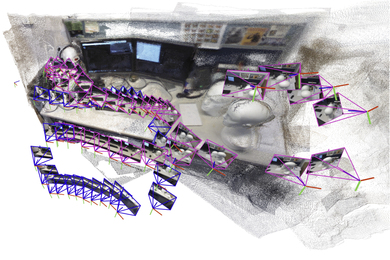Medical physicists at MIT have found a way to interpret the subtle electrical warning signals the human heart generates when it is prone to ventricular fibrillation-the sudden, uniformly fatal occurrence of a wildly irregular heart beat.
The accomplishment may lead to the development of a noninvasive diagnostic test to predict the likelihood of sudden cardiac death in adults. The MIT technology has been licensed to Cambridge Heart, Inc., of Burlington, MA, which is seeking to produce such a test.
Sudden cardiac death remains a major unresolved clinical and public health problem, claiming more than one life every two minutes in the United States. There are more than 300,000 sudden cardiac deaths each year, most affecting people over 65 years old, but in many cases-the late Reggie Lewis of the Boston Celtics is an example-young people in apparent vigorous health are felled. Ventricular fibrillation, the disturbance of electrical conduction in the main pumping chambers of the heart, is the most serious kind of ventricular arrhythmia. It is implicated in the vast majority of sudden deaths in adults
Dr. Richard J. Cohen, MD, PhD, who directs the Harvard-MIT Center for Biomedical Engineering and who founded Cambridge Heart, led the research at MIT. Drs Joseph Smith and Dan Adam in Dr. Cohen's laboratory conducted extensive computer simulations and animal tests to study the relationship between subtle, beat-to-beat variability in electrocardiographic waveforms and susceptibility to ventricular arrhythmia. They discovered that a particular pattern of variability-electrical alternans-was highly correlated with susceptibility to ventricular arrhythmia. Drs. Smith and Cohen then developed a computer method based on spectral analysis to detect electrical alternans. This method has been initially tested in a pilot human study.
A large clinical study of the approach to identifying individuals at risk was then undertaken at the Massachusetts General Hospital. The highly successful results were reported in the January 27, 1994, issue of the New England Journal of Medicine.
"Although much more work needs to be done and corroborating studies need to be performed, we are very encouraged by these results," Dr. Cohen said.
Electrical alternans has been known to exist for more than 75 years, but for most of that time it has been viewed as an "electrocardiographic curiosity," the joint MIT-MGH research team wrote in the journal article.
The presence of the signals "has only recently been appreciated as a possible harbinger of sudden cardiac death," they wrote. Reports linking electrical alternans with ventricular fibrillation in patients with a variety of heart problems have been largely anecdotal. Before the work from Dr. Cohen's laboratory, there had not been any systematic evaluation of using electrical alternans in evaluating the risk of ventricular arrhythmias.
The computer algorithm developed by the MIT research team measures T-wave (repolarization) alternans even when it cannot be observed by visual inspection of the electrocardiogram. The algorithm can quantify alternans at a microvolt level. The amplitude of electrocardiographic waveforms is typically 1,000 times greater.
"Previously, the inability to measure alternans at a microvolt level explains why the relationship between alternans and arrhythmias had not been appreciated," said Dr. Cohen.
Using the MIT technology, researchers tested 83 patients known to be at risk for ventricular arrhythmia at Massachusetts General Hospital and followed them for 20 months. It was found that 81 percent of those in whom electrical alternans was detected either succumbed to ventricular fibrillation or suffered a life-threatening episode of ventricular arrhythmia. Only six percent of those in whom electrical alternans was not present were similarly affected, the researchers reported.
The computer program used to analyze the electrocardiograms in the clinical study was developed by Dr. Smith, Dr. David S. Rosenbaum and Dr. Cohen. The clinical study was conducted by Dr. Rosenbaum, now of Case Western Reserve University, Cleveland, in conjunction with an MGH-MIT team led by Dr. Jeremy Ruskin, director of cardiac electrophysiology at MGH, and by Dr. Cohen at MIT.
The signal-processing technique is capable of isolating the electrical alternans pattern of fluctuations in the electrocardiogram from much larger fluctuations caused by the subject's breathing, for example, or for other physiological reasons.
Electrical alternans was at the microvolt level and was not detected by visual inspection of the electrocardiogram in nearly all patients in whom alternans was detected by the computer algorithm. In addition, the measurement technique developed does more than simply indicate the presence or absence of alternans. The system can quantify the magnitude of alternans present in any segment of the electrocardiogram.
"This methodological point was critical to our result because alternans was not an `all or none' phenomenon," the researchers wrote.
The researchers found that repolarization alternans "was as predictive as invasive electrophysiological testing" in predicting arrhythmia. This invasive procedure involves the placement in the heart of electrode catheters in a deliberate attempt to induce ventricular arrhythmias. It is very costly and carries risk for the patient."
They wrote: "Although it would be premature to suggest that repolarization alternans be used as an alternative to electrophysiological testing, the present study does suggest that repolarization alternans may be useful for evaluating several patient groups. For example, screening patients with syncope might provide a means of identifying high-risk patients that are suitable for electrophysiological testing."
Syncope-unexplained fainting-was the condition associated with the late Reggie Lewis of the Celtics.
A version of this article appeared in the March 2, 1994 issue of MIT Tech Talk (Volume 38, Number 24).





